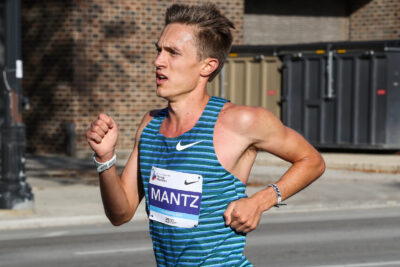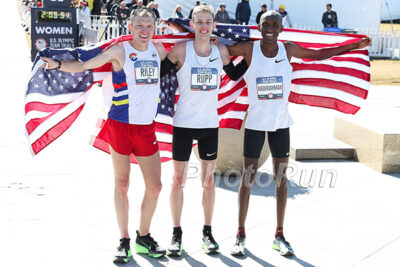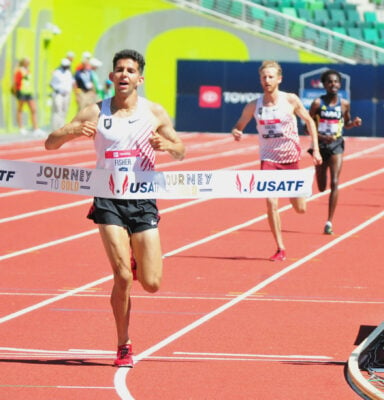World Athletics Announces Toughest-Ever Standards for 2024 Olympics
By LetsRun.com
December 20, 2022
On Tuesday, World Athletics announced the automatic qualifying standards for the 2024 Olympics in Paris. The standards are the toughest ever for a global championship as World Athletics is aiming for just 50% of entrants to come via the standard, with the remaining 50% to be determined by world ranking.
This is similar to the system in place for the 2023 World Championships in Budapest, and in most events, the standards are similar to those for next year’s Worlds. The big difference comes in the marathon.
For the 2020 Olympics, World Athletics had set entry limits of 80 athletes for the men’s and women’s marathons, but a combination of supershoes and a COVID-extended qualifying window saw far more athletes hit the entry standards than expected. In the end, 106 men and 88 women started the last Olympic marathon in Sapporo.
Seeking to avoid a repeat, World Athletics dramatically lowered the marathon entry standards. On the men’s side, the 2024 standard is 2:08:10 (compared to 2:11:30 in 2020). On the women’s side, the 2024 standard is 2:26:50 (compared to 2:29:30 in 2020). Athletes can also earn the standard by finishing top-5 in a Platinum Label Marathon between November 1, 2022, and April 30, 2024. In 2023, the following races are Platinum Label Marathons: Xiamen, Osaka (women), Tokyo, Nagoya (women), Seoul, Boston, London, Sydney, Berlin, Chicago, Amsterdam, New York, Shanghai, Valencia.
The standards are listed below. We’ve also listed the standards for the 2020 Olympics and 2023 Worlds for comparison.
Men’s standards
| Event | 2020 Olympics | 2023 Worlds | 2024 Olympics |
| 100m | 10.05 | 10.00 | 10.00 |
| 200m | 20.24 | 20.16 | 20.16 |
| 400m | 44.90 | 45.00 | 45.00 |
| 800m | 1:45.20 | 1:44.70 | 1:44.70 |
| 1500m | 3:35.00 | 3:34.20 (3:51.00) | 3:33.50 (3:50.40) |
| 5000m | 13:13.50 | 13:07.00 (13:07 road) | 13:05.00 |
| 10,000m | 27:28.00 | 27:10.00 (27:10 road) | 27:00.00 |
| Marathon | 2:11:30 | 2:09:40 | 2:08:10 |
| 3000m SC | 8:22.00 | 8:15.00 | 8:15.00 |
| 110m H | 13.32 | 13.28 | 13.27 |
| 400m H | 48.90 | 48.70 | 48.70 |
| High jump | 2.33m | 2.32m | 2.33m |
| Pole vault | 5.80m | 5.81m | 5.82m |
| Long jump | 8.22m | 8.25m | 8.27m |
| Triple jump | 17.14m | 17.20m | 17.22m |
| Shot put | 21.10m | 21.40m | 21.50m |
| Discus | 66.00m | 67.00m | 67.20m |
| Hammer | 77.50m | 78.00m | 78.20m |
| Javelin | 85.00m | 85.20m | 85.50m |
| Decathlon | 8350 pts | 8460 pts | 8460 pts |
| 20k RW | 1:21:00 | 1:20:10 | 1:20:10 |
Women’s standards
| Event | 2020 Olympics | 2023 Worlds | 2024 Olympics |
| 100 | 11.15 | 11.08 | 11.07 |
| 200 | 22.80 | 22.60 | 22.57 |
| 400 | 51.35 | 51.00 | 50.95 |
| 800 | 1:59.50 | 1:59.80 | 1:59.30 |
| 1500 (Mile) | 4:04.20 | 4:03.50 (4:22.00) | 4:02.50 (4:20.90) |
| 5k | 15:10.00 | 14:57.00 (14:57 road) | 14:52.00 |
| 10k | 31:25.00 | 30:40.00 (30:40 road) | 30:40.00 |
| Marathon | 2:29:30 | 2:28:00 | 2:26:50 |
| 3k steeple | 9:30.00 | 9:23.00 | 9:23.00 |
| 100 hurdles | 12.84 | 12.78 | 12.77 |
| 400 hurdles | 55.40 | 54.90 | 54.85 |
| HJ | 1.96m | 1.97m | 1.97m |
| PV | 4.70m | 4.71m | 4.73m |
| LJ | 6.82m | 6.85m | 6.86m |
| TJ | 14.32m | 14.52m | 14.55m |
| SP | 18.50m | 18.80m | 18.80m |
| Discus | 63.50m | 64.20m | 64.50m |
| Hammer | 72.50m | 73.60m | 74.00m |
| Javelin | 64.00m | 63.80m | 64.00m |
| Heptathlon | 6420 pts | 6480 pts | 6480 pts |
| 20k race walk | 1:31:00 | 1:29:20 | 1:29:20 |
Qualifying windows
Marathon: November 1, 2022 – April 30, 2024
10,000m, combined events, race walk, relays: December 31, 2022 – June 30, 2024
All other events: July 1, 2023 – June 30, 2024
Quick Take: The qualifying system is mostly good news for American marathoners
There’s a little of bad news but mostly good news for American marathoners today. The bad news — especially for the US men — is that the new Olympic standards are really hard.
Guess how many American men ran faster than the 2:08:10 Olympic standard in 2022? Zero. And none finished in the top 5 of a Platinum Label Marathon either.
On the women’s side, it was much better: 10 US women ran under the 2:26:50 standard.
It’s going to be hard for any American men to hit the standard before the window closes on April 30, 2024. Only six Americans have ever run 2:08:10 or faster in the marathon. Two of them are active athletes: Galen Rupp (2:06:07 pb) and Leonard Korir (2:07:56 pb), though both men are now 36 years old and Rupp has struggled to stay healthy this year. Conner Mantz ran the fastest marathon by an American this year, 2:08:16 in his debut in Chicago, and has a decent shot to hit the standard in 2023. Scott Fauble, who ran 2:08:52 on an ineligible course in Boston in April, could also have a shot, but it’s hard to see anyone else hitting the time standard.
The good news for American marathoners is that it doesn’t matter that hardly any US men will be able to hit the marathon standard. The Olympic marathon field is even more heavily dependent on world rankings than other events. The top 65 athletes on World Athletics’ “Road to Paris” list as of January 30, 2024, will be considered qualified. That list includes a limit of three athletes per country, which means you can be ranked way lower than 65th and still be qualified.
The Road to Paris list isn’t published yet, but we can use the current world rankings to project which athletes would be qualified as of now (though obviously the rankings will change between now and January 2024).
On the men’s side, the #65 athlete right now, using a limit of three athletes per country, is Somalia’s Khadar Basheer Youssuf, who is ranked 291st overall. There are currently 10 Americans ranked ahead of him: Rupp, Elkanah Kibet, Mantz, Fauble, Nico Montanez, Matt McDonald, Futsum Zienasellassie, Frank Lara, Zach Panning, and Colin Mickow.
On the women’s side, the #65 athlete is the Netherlands’ Ruth van der Meijden, who is ranked 253rd overall. There are 20 Americans ranked ahead of her (we’re not going to list them all).
This leads to our next point…
Quick Take: The 2024 US Olympic Marathon Trials should be as great as ever
Ever since World Athletics announced that the 2024 Olympic standards would be dramatically harder than in 2020, there has been concern about how that might affect the greatest of all American marathons: the US Olympic Marathon Trials. If the standards were so tough that only a few Americans could hit them, would the Trials be robbed of the top-three-or-bust drama that makes it so great?
After reviewing the Olympic qualification system, US marathon fans don’t have much to worry about. It is very likely that the top three finishers in both the men’s and women’s Trials will be the team that the USA sends to Paris.
First, the timing works very nicely for the Trials. The top 65 athletes as of January 30, 2024, will be automatically qualified. The Trials will be held on February 3, 2024. So we’ll know exactly which athletes are qualified when the gun fires in Orlando.
The US currently has 10 men and 20 women currently ranked ahead of the #65 athlete. If those numbers remain roughly the same on January 30, 2024, a significant number of top American marathoners will know they’re guaranteed an Olympic berth with a top-three finish.
And it gets better. Remember in June when World Athletics announced a somewhat confusing “quota reallocation system” for the marathon? That system allows USATF to sub out any or all of its qualified athletes with a replacement, as long as the replacement has run 2:11:30 or 2:29:30 within the window. Since the US shouldn’t have a problem getting three athletes in the top 65, that means that anyone who has run 2:11:30 or 2:29:30 in the window would also be guaranteed an Olympic berth with a top-three finish at the Trials (assuming USATF takes advantage of the quota reallocation system). And even athletes who haven’t hit those times would be able to clinch an Olympic berth by running 2:11:30 or 2:29:30 at the Trials and finishing in the top three.
The one concern is if it’s a hot day in Orlando. If the Trials are held in the late morning for TV purposes, temperatures could run into the 70s — higher if it’s a hot day. In that situation, it might be possible for someone to finish in the top three by running slower than 2:11:30 or 2:29:30.
This would all be a lot simpler if World Athletics simply allowed any country with at least three qualifiers to name whatever team they wanted. But the bottom line is that the new qualifying system shouldn’t have much impact on the US Olympic Marathon Trials.
Quick Take: The other distance standards are very tough
It is not going to be easy for Americans to hit the Olympic standards, particularly on the men’s side. Here’s a look at how many Americans ran faster than the 2024 Olympic standards this year:
Men
800 (1): Bryce Hoppel
1500 (3): Yared Nuguse, Cooper Teare, Cole Hocker
5000 (3): Grant Fisher, Joe Klecker, Emmanuel Bor
10,000 (1): Grant Fisher
Steeple (1) : Hillary Bor
Marathon (0): None
Women
800 (10): Athing Mu, Ajee’ Wilson, Sage Hurta, Raevyn Rogers, Olivia Baker, Allie Wilson, Nia Akins, Juliette Whittaker, Brooke Feldmeier, Roisin Willis
1500 (8): Heather MacLean, Sinclaire Johnson, Elise Cranny, Elle St. Pierre, Cory McGee, Karissa Schweizer, Sage Hurta, Josette Norris
5000 (3): Alicia Monson, Elise Cranny, Courtney Frerichs
10,000 (2): Elise Cranny, Karissa Schweizer
Steeple (3): Emma Coburn, Courtney Wayment, Courtney Frerichs
Marathon (10): Emily Sisson, Keira D’Amato, Sara Hall, Emma Bates, Lindsay Flanagan, Dakotah Lindwurm, Susanna Sullivan, Sarah Sellers, Aliphine Tuliamuk, Sara Vaughn
The biggest effect will likely come in the 10,000’s. Only three American men and four American women have ever run under the standards of 27:00.00 and 30:40.00. The US should still be able to send a full team, but there will likely be only a few people who enter the Olympic Trials with a shot at the team. The field size at the Olympics is capped at 27. The #27 man in the world right now (limit three athletes per country) is Stanford’s/Australia’s Ky Robinson, whose PR is nowhere close to 27:00 (it’s 27:47). The US has four men ranked higher than him (Grant Fisher, Joe Klecker, Sean McGorty, Conner Mantz). On the women’s side, Australia’s Rose Davies is #27. The US has seven women ranked higher than her (Karissa Schweizer, Alicia Monson, Elise Cranny, Natosha Rogers, Weini Kelati, Emily Sisson, Stephanie Bruce).
UPDATE: Things could get tricky in the 10,000 meters now that World Athletics has said that the top eight athletes in the World Cross Country Ranking who don’t already have the standard will be considered qualified. Looking at the current Road to Budapest rankings, the US only has two qualified athletes in the women’s 10,000 with Alicia Monson just outside the world rankings quota behind a number of athletes who stand to qualify via their World Cross Country Ranking. We’ll look into this further with World Athletics.
Americans in every event will be faced with a choice as the qualifying window opens: gear your efforts toward one or two time-trial-type races in order to secure the standard, or race a bunch to bring up your world ranking. By instituting this new system, World Athletics is clearly hoping for the latter.
Quick Take: It’s now much harder to qualify for the Olympics in the 200 and steeplechase
World Athletics has been ordered by the IOC to reduce the number of athletes at the 2024 Olympics. Track & field was given 1,900 athlete slots at the 2020 Olympics but that number is down to 1,810 for 2024.
Where did World Athletics make cuts? They eliminated the men’s 50k race walk (60 slots) and trimmed the 20k race walk fields from 60 slots per gender to 48 per gender — though WA also added a mixed team race walk event (50 slots). That’s a net loss of 34 slots in the race walk overall.
Only two other events saw cuts: the 200, which went from 56 athletes per gender to 48, and the steeplechase, which went from 45 athletes per gender to 36. Combined, that’s another 34 slots reduced. We’d love to hear why the steeple and 200 were cut so dramatically while no other track & field events were touched at all.
Quick Take: We really wish World Athletics had a “quota reallocation system” for the all events
The US is almost certainly going to send three entrants in all of the distance events. Why does World Athletics care which three it is? The drama of the US Olympic Trials is amazing if the top three actually make it. World Athletics should do for track what they’ve done for the marathon: institute a quota reallocation system. If the standards for that were 13:30/28:00 for the men’s 5,000 and 10,000, the sport would benefit and there would be no downsides. A 27:59 guy who finishes top three at the Trials isn’t going to embarrass himself at the Olympics any more than someone who ran 26:59 a year earlier but is now hurt.
Discuss the 2024 Olympic standards on the LetsRun.com messageboard:





